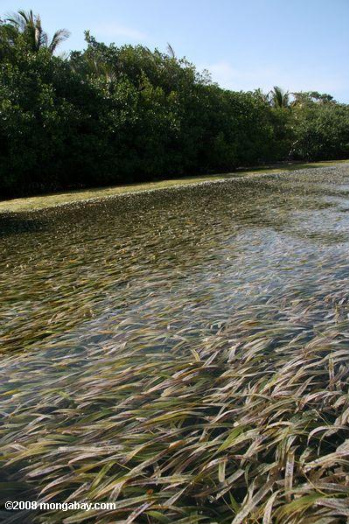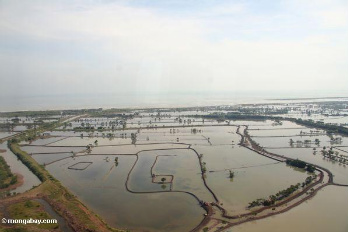Highly endangered coastal habitats are incredibly effective in sequestering carbon and locking it away in soil, according to a new paper in a report by the IUCN. The paper attests that coastal habitats—such as mangroves, sea grasses, and salt marshes—sequester as much as 50 times the amount of carbon in their soil per hectare as tropical forest.
“The key difference between these coastal habitats and forests is that mangroves, seagrasses and the plants in salt marshes are extremely efficient at burying carbon in the sediment below them where it can stay for centuries or even millennia. Tropical forests are not as effective at transferring carbon into the soil below them, instead storing most carbon in the living plants and litter,” explains the paper’s author and Conservation International’s Marine Climate Change Director, Dr. Emily Pidgeon. “But coastal ecosystems keep sequestering large amounts of carbon throughout their life cycle. Equally, the majority of carbon stays locked away in the soil rather than the plant, so only a relatively small amount is released when the plant dies.”
 Seagrass and mangroves in Belize. Photo by: Rhett A. Butler. |
This capacity for coastal environments to lock away carbon for thousands of years has largely been ignored in accounts of the global carbon cycle, according to the paper, even though the amount of carbon they are responsible for storing is very high.
Coastal habitats with vegetation “[contribute] about half of the total carbon sequestration in ocean sediments even though they account for less than 2 percent of the ocean surface,” Pidgeon writes, explaining that much of this is capacity is due to the fact that coastal vegetation usually spreads deeper below ground than it grows above with some plants going as deep as eight meters.
According to Pidgeon, salt marshes, mangroves, and seagrasses store ten times more carbon in their soils per hectare than temperate forests and fifty times more than tropical forests.
“The simple implication of this is that the longterm sequestration of carbon by one square kilometer of mangrove area is equivalent to that occurring in fifty square kilometers of tropical forest. Hence, while relatively small in area, coastal habitats are extremely valuable for their longterm carbon sequestration capacity,” Pidgeon writes in the paper.
Pidgeon believes that even these remarkable figures may be underestimations, since the accumulation rates do not take into account tidal pumps that move carbon from coastal environments into the open ocean. No studies have yet determined just how much of an affect these tidal pumps have on the carbon cycle.
 Deforested mangroves in Indonesia. Photo by: Rhett A. Butler. |
However, according to Pidgeon, these findings should not diminish the importance of preserving forests in mitigating climate change.
“The sheer size of the world’s forests makes them essential for carbon sequestration. However, the immense carbon sequestration capacity of these coastal habitats has been almost completely ignored and may also be a vital component in global efforts to mitigate climate change,” she says.
Yet, coastal habitats are vanishing with incredible speed. According to the paper, 20 percent of mangroves have been lost in the past thirty years. In total, seagrasses have lost 29 percent of their historical distribution. These ecosystems are being converted for agriculture, aquaculture (such as shrimp farming), development, and tourism. The massive and continuing conversion of these ecosystems is having a big impact on our planet.
“The total annual loss of mangroves and seagrasses has the longterm carbon sequestration capacity of a tropical forest area similar to the annual deforestation rate in the Amazon,” writes Pidgeon.
Coastal environments are not just important for carbon sequestration. Mangroves provide a number of vital ecosystem services, according to Pidgeon, such as protection from extreme weather and natural disasters like tsunamis and important habitat for natural fish nurseries, providing an important source of food for local communities.
“Not only do these ecosystems help us to remove carbon from the atmosphere, but they are also very important as an adaptation tool to help some of the world’s most vulnerable people to avoid the worst impacts of climate change,” writes Pidgeon. “It is imperative that we take steps to protect them immediately.”
CITATION: Emily Pidgeon. Carbon Sequestration by Coastal Marine Habitats: Important Missing Sinks. The Management of Natural Coastal Carbon Sinks. IUCN. 2009.
Related articles
New report: boreal forests contain more carbon than tropical forest per hectare

(11/12/2009) A new report states that boreal forests store nearly twice as much carbon as tropical forests per hectare: a fact which researchers say should make the conservation of boreal forests as important as tropical in climate change negotiations. The report from the Canadian Boreal Initiative and the Boreal Songbird Initiative, entitled “The Carbon the World Forgot”, estimates that the boreal forest—which survives in massive swathes across Alaska, Canada, Northern Europe, and Russia—stores 22 percent of all carbon on the earth’s land surface. According to the study the boreal contains 703 gigatons of carbon, while the world’s tropical forests contain 375 gigatons.
Declaration calls for more wilderness protected areas to combat global warming

(11/11/2009) Meeting this week in Merida, Mexico, the 9th World Wilderness Congress (WILD9) has released a declaration that calls for increasing wilderness protections in an effort to mitigate climate change. The declaration, which is signed by a number of influential organizations, argues that wilderness areas—both terrestrial and marine—act as carbon sinks, while preserving biodiversity and vital ecosystem services.
Mangroves save lives by softening cyclone’s blow

(04/15/2009) In 1999 a super cyclone struck the eastern coast of India, leaving 10,000 people dead. At the time the Orissa cyclone, named after the Indian state which it battered, was the deadliest storm in India in over a quarter century. However, according to a new study published in The Proceedings of the National Academy of Sciences the death toll would have been significantly higher if the mangrove forests buffeting the Indian villagers from the sea had not softened the cyclone’s blow.
Coral reefs and mangroves worth $395-559 M per year in Belize
(11/14/2008) Services provided by coral reefs and mangroves in Belize are worth US$395 million to US$559 million per year, or 30 to 45 percent of the Central American country's GDP — according to a new report released by the World Resources Institute and the World Wildlife Fund (WWF).
Mangrove destruction for fish trade may undermine fishermen in West Africa
(09/15/2008) The harvesting of mangrove forests in West Africa for the smoked fish trade threatens to undermine the primary source of income for the very fishermen who supply fish to the market, reports a study published Monday in the open-access journal Tropical Conservation Science.
How to replant a mangrove forest: local, low-cost initiatives prove most successful
(07/23/2008) Mangrove replanting and rehabilitation has become a widespread and important environmental initiative worldwide. Mangrove forests play key ecological roles, including sustaining fish populations and other wildlife, preventing erosion along coastlines, and acting as an overall carbon sink. Furthermore, mangroves have received attention lately for their role in providing an effective buffer against typhoons. In light of the many replanting initiatives now occurring, researchers J.H. Primavera and J.M.A. Esteban conducted a study of the overall effectiveness of different mangrove rehabilitation schemes. Their findings show that small, local, and generally cheaper initiatives have a higher success rate over large costly government and international programs.
Mangroves are key to healthy fisheries, finds study
(07/21/2008) Mangroves serve as a critical nursery for young marine life and therefore play an important role in the health of fisheries and the economic well-being of fishermen, report researchers writing in the early online edition of the Proceedings of the National Academy of Sciences.
Destruction of wetlands worsens global warming
(07/20/2008) Destruction of wetland ecosystems will generate massive greenhouse gas emissions in coming years, warn experts convening at an international wetlands conference in Brazil.













